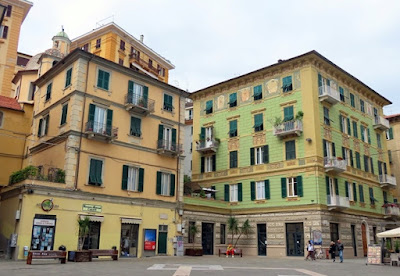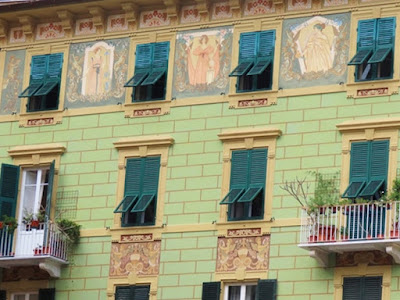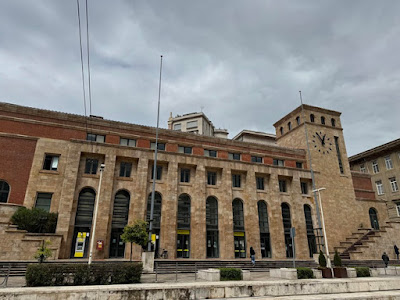
La Spezia is often seen as a transit point for the smaller, picturesque localities around it,
yet it offers pleasant surprises: museums, the lively Via del Prione, the
renovated Piazza Giuseppe Verdi and the Morin promenade, with its spectacular
views of the gulf and the Apuan Alps (the mountain range is also known as Carrara marble).

It is quite typical to see
lined up orange trees in Liguria towns. When we stepped out La Spezia Centrale
Station, sweet orange fragrance appealed to us. The trees lined up
next to the pavement. A nontragic and cosy welcome!

We spent the next 3 sunny days
in Cinque Terre, Portovenere, Lerici and Tellaro. The first sightseeing point
in La Spezia is the San Giorgio Castle and its archeological museum. The exhibits are from pre-history (as early
as the Copper Age, i.e. the 4th millennium B.C.) to the Middle Ages. It also
contains an extensive display of Roman artefacts including objects excavated from
the nearby Luni (a Roman city located on the border between Tuscany and
Liguria) settlement. The most
fascinating pieces are the stelae statues (ancient, upright stone monument). Usually,
stelae were carved with inscriptions and used as grave markers, territory or
boundary marker, or even a way to publicize new laws or a ruler's military
successes. They are dated to the Copper period, 4th – 3rd
millennia B.C. 19 originals are exhibited in the museum. 

San Giorgio Castle is located
on a small knoll which oversees the town, harbour and islands nearby. A reward
of visiting the archeological museum is the panoramic views at its terraces on the two floors.




Don’t want to walk over? There are
vertical lifts, from Via Indipendenza (next to Via del Prione and MyHotel) and a
second one from Via XX Settembre and reach the Castle in Via XXVII Marzo. But if you are young / strong, consider to walk up the Quintino Sella staircase. There are at least 20 major stairways in La Spezia neighbouring beautiful Art Nouveau buildings or even older ones.
Between the end of the 19th century and the beginning of the 20th century, La Spezia experienced a great demographic and urban development, matched by an artistic and cultural growth, especially in architecture. In the historical centre of La Spezia are clusters of splendid buildings competing admiration from visitors and local people. A bit higher up, close to the Castello San Giorgio, are lavish palaces overseeing the gulf, yachts and ships.

The port of La Spezia has been important for centuries. It was further developed in the 19th century and has since been one of Italy’s main commercial ports, specializing in container handling. Piles of containers, navies, large cruise ships fill different corners of the port.
The
Thaon de Revel Bridge was opened in July 2013, to connect the port and the mainland. Be there to enjoy panoramic views of the port, walk opposite to stroll along the
Costantino Morin Promenade and enjoy the charm of the public gardens. You will see a gigantic statue of Giuseppe Garibaldi. Indeed, nice
monuments are present everywhere in the town. Keep your eyes open.
Piazza Giuseppe Verdi is located a few streets parallel to Costantino Morin Promenade. Public buildings like central post office, schools are around. It is a major traffic spot yet space available for people to interact and relax. Wide tree-lined sidewalks, fountains, orange groves and arches (
Archi di Daniel Buren) compose a restful place amid the bustling environment. The yellow and blue arches link our hearts to Ukraine. Wish that the war will be ended soon and the Russians driven away.
We passed by the
Cattedrale di Cristo Re of La Spezia while on the bus to
Portovenere. It is an immense round concrete building sitting over Piazza Europa. The outlook and interior are totally different from any form of churches. The interior is simple but solemn. A vast dome, with a big eye and Jesus on the cross, is supported by twelve big pillars representing the twelve apostles. Each column is named after Jesus’ disciples. Judas of Iscariot is replaced by Matthias.



La Spezia offers a lot to see. Please assure to spare time for
Museo Civico Amedeo Lia. It is a “art gem” that stands in the ancient monastery of the Minim Friars of St. Francis of Paola. The Museum houses a collection of about 1000 works, ranging from the Classical Period to the Late Antiquity, to the Middle Ages until the 18th Century. The collection displays miniatures, bronze sculptures, copper, ivory, wood, as well as a series of glass works and maiolica and a variety of art objects that testify the excellence of Italian and European art. The “diamonds” of the Museum are undoubtedly the series of so-called “primitives”, with more than 70 tables by
Pietro Lorenzetti and other artists of the period, as well as canvases by
Tiziano,
Pontormo and
Tintoretto.































Comments